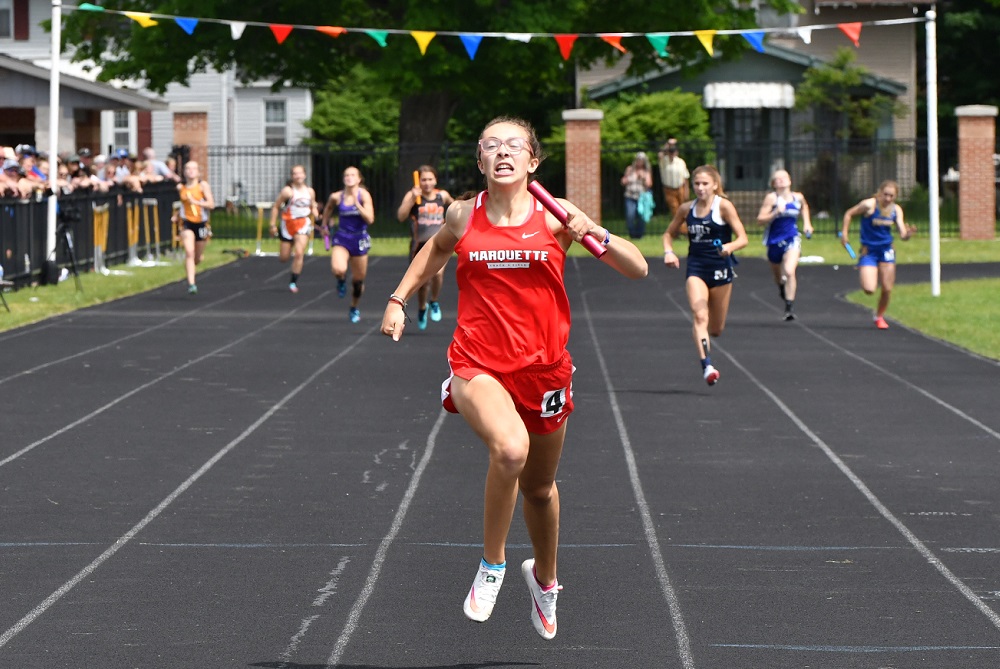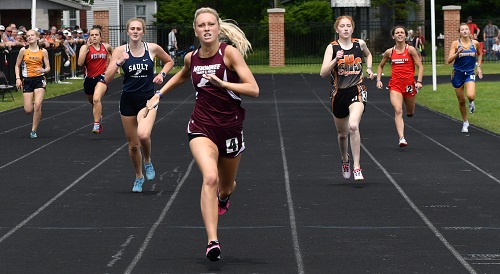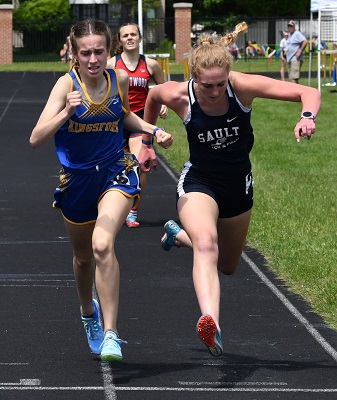
Truckey Paces Marquette's Run in UP Division 1
By
John Vrancic
Special for MHSAA.com
June 6, 2021
KINGSFORD — Sophomore Baux Truckey had a hand in four firsts Saturday at Kingsford, helping the Marquette girls retain their Upper Peninsula Division 1 track title with 120 points.
They were followed by Sault Ste. Marie with 94 points and Menominee with 71 on a hot and humid day at Flivver Field.
Truckey anchored the 400-meter relay which set the UPD1 Finals record at 50.11 seconds, topping the previous best (51.22) by Gladstone in 2007.
She also anchored the 800 relay (1:47.14), won the 100 (12.79) and edged teammate Julia Ott on a lean in the 200 (26.58).
 “Our handoffs went real well,” said Truckey. “Going 1-2 in the 200 was fun, but the heat was a factor. It was a relief to get done today. We have a lot of competition in practice, which I think is very helpful.”
“Our handoffs went real well,” said Truckey. “Going 1-2 in the 200 was fun, but the heat was a factor. It was a relief to get done today. We have a lot of competition in practice, which I think is very helpful.”
Ott won high jump at five feet and was clocked in 13.1 and 26.6 in the 100 and 200, respectively.
Kali McDonough captured pole vault (10-1), and Olivia Moffitt added a first in the 3,200 (12:00.03).
Sault senior Emily McLean set the UPD1 shot put record again, at 42-8½, topping her own mark (39-2) from two years ago.
The Central Michigan University recruit was crowned Straits Area Conference champion May 24 with a school-record toss of 46-8, then won at Tuesday’s Northern Michigan Meet of Champions at Gaylord (43-4).
“The heat was a factor,” she said. “It was kind of crazy. We were in the sun quite a while, although today’s weather forecast helped us mentally prepare for the heat. We knew what was coming.
 “I had kind of an off day in discus, but Joanne (Arbic, of Sault Ste. Marie) had a nice throw. I’m definitely excited for her and about going to Central.”
“I had kind of an off day in discus, but Joanne (Arbic, of Sault Ste. Marie) had a nice throw. I’m definitely excited for her and about going to Central.”
Houghton’s Lillian Williston won discus (116-10). Arbic placed second (114-7) and McLean was fourth (106-3).
Menominee senior Makenzie Wellner became a four-event winner, taking the 100 hurdles (15.7), 300s (46.7), long jump (16-8) and anchoring the winning 1,600 relay (4:11.6), which previously had set the school record at 4:09.01 in Marinette, Wis., on May 25.
“Our coach (Scott Melchoir) helped me with my approach and helped me jump a little further,” said Wellner, who plans to run track at Wayne State next season. “I was feeling good today. It was hard to find space under the bleachers today (due to the heat).”
Hayden Buck added a first in the 400 in a school-record 59.77 seconds.
In the 1,600, Houghton sophomore Ingrid Seagren ran second nearly the whole race before sneaking past Marquette’s Guinn Wuorinen for the victory. Seagren was clocked in 5:34.49 with Wuorinen at 5:34.59.
In another tight race, Kingsford’s Melanie Wenzel won the 800 (2:29.55), edging Sault senior Haleigh Knowles on a lean.
PHOTOS: (Top) Marquette's Baux Truckey anchors the 400 relay and crosses the finish line first Saturday at Kingsford. (Middle) Menominee's Hayden Buck crosses the finish line first in the 400. (Below) Kingsford's Melanie Wenzel, left, beats Sault Ste. Marie's Haleigh Knowles to the finish line. (Photos by Cara Kamps. Click to see more at RunMichigan.com.)

Track Gaining Speed Toward Future with Electronic Starting Devices
By
Steve Vedder
Special for MHSAA.com
May 23, 2023
Aubrey Greenfield thinks it might be the perfect time to reevaluate 130 years of tradition.
For a number of reasons, from technical to personal, the Oxford senior sprinter believes it makes sense for the crack of a starting pistol to be eliminated from high school track meets.
Because track meets would benefit in various ways from lowering costs to easier setup at meets to the human factor of competitors not having to flinch at the crack of a pistol shot, Greenfield believes the sport has a chance to embrace new technology – electronic starting devices (ESD).
In essence, an ESD replaces the starting pistol with a light flash, tone sound or both to begin a race.
"High school sports should put the athlete first," Greenfield said. "We should promote sports, and eliminating starting pistols promotes health in terms of PTSD or trauma for athletes and spectators and that would be good. I would like to think people would say that's a good idea."
In fact, Greenfield would go as far as to say if there was not an implementation of electronic starting devices, many of her teammates would have considered giving up the sport.
"If it's something that helps us compete safely, we're all for it," she said.
Greenfield's opinion apparently is spreading. Michigan High School Athletic Association senior assistant director Cody Inglis said the use of ESD makes it both affordable for meet starters and sensible for athletes and fans to rethink the use of starting pistols. While the MHSAA is not mandating electronic starting devices, it does promote the use of what Inglis calls "emerging technology." He notes that ESD are becoming the norm for organizations such as USA Track & Field, the NCAA and an increasing number of high schools.
 "I think we have to embrace new technology, and we think this will be something that takes hold," Inglis said.
"I think we have to embrace new technology, and we think this will be something that takes hold," Inglis said.
A key part of embracing ESD is the human element. The tragic Oxford High School shooting Nov. 30, 2021, that took the lives of four students while injuring seven others should not be relived even for a fleeting instance at a high school sporting event. Oxford athletic director Tony DeMare said the school began using ESD at every meet, including the MHSAA Lower Peninsula Division 1 Finals last June. He said that decision was embraced by virtually all schools Oxford encountered.
"We were very convinced that the alternative (of ESD) would promote a healthy attitude," DeMare said. "We were overwhelmed with the positive response. If a school was on the fence about it or might not be for it, I think we've started to see the tide turn in favor of people willing to listen and learn about electronic starting devices."
Inglis said the MHSAA is acutely aware of what the crack of a starting pistol can mean to athletes and fans.
"It's unimaginable what Oxford went through, and this is a small way we can help," he said. "We look at a (starting pistol) and think, ‘Could we do something else?’ It's a way of helping to solve a problem."
Over the last several years, the MHSAA has embraced finding an alternative to starting pistols. Inglis noted the discussion started with the cost and diminishing availability of 32-caliber ammunition that meet starters use. A box of ammunition, if it can be found, is around $75 a box.
In addition to cost, there is potential damage from excessive exposure to 150-plus decibels of sound generated by the traditional 32-caliber blanks. Medical studies show damage to ears caused by decibel levels above 120 dB.
The tragedy at Oxford accelerated the conversation.
Inglis said the cost of ESD can be likened to a school sinking money into artificial surfaces at football fields. Yes, there is a great cost at first, but over time money is ultimately saved. An ESD system itself ranges between $200 and $500. Speakers also may need to be purchased, but with ESD starting events like the 800 and 1,600-meter relays positioned near the outside lanes 8, 7, 6 and 5 would result in improved hearing by athletes at the start of a race.
There is one challenge with ESD that track administrators are working to overcome – lighting conditions that lessen the ability to see the ESD’s LED light or strobe when the button is pressed by a starter to begin a race. But that vision difficulty resulting from clear blue skies and backgrounds of setting suns can be substantially improved by incorporating a black background with an ESD – something as simple as a starter holding up black cardboard behind the lighting mechanism at the start of an event.
Inglis said when all factors are considered, the use of ESD makes sense.
 "With the climate we live in nowadays, no lookalike guns is good," he said. "We're not mandating this. But people are saying this is affordable."
"With the climate we live in nowadays, no lookalike guns is good," he said. "We're not mandating this. But people are saying this is affordable."
While switching to ESD would break 130 years of tradition, the timing could be a step forward, said Jeff Hollobaugh, co-author of the book "The Fleet Feet of Spring: Michigan's High School State Championships in Track & Field." He said while no definitive answer is possible, it's likely starting pistols were used at the inaugural state meet at the Jackson Fairgounds in 1895. The meet, which included events like tossing a 16-pound shot put, bike races and a 100-meter sprint, was sponsored by the Michigan Interscholastic Athletic Association (a predecessor to the MHSAA) and comprised mostly of the state's larger schools.
Hollobaugh's sentiments echo what many involved in today's high school track & field believe in terms of making a transition from starting pistols to electronic starting devices.
"It's a change, not necessarily good or bad, just different," he said. "It's not a drastic change, but it will take some getting used to. But it is the future. In the end, we'll all be fine."
DeMare believes the future of high school track will definitely include ESD.
"Our desire is that the practicality and sensibility of this will overcome the alternative," he said. "I think we'll see the automation and electronics taking hold of certain elements in track, and people will embrace it."
PHOTOS (Top) Runners watch official Bertha Smiley as they prepare to begin a race during last season's Lower Peninsula Division 1 Finals at Rockford. (Middle) An electronic starting device provided by VS Athletics was used to start those races. (Below) Smiley sets to begin an event. (Photos provided by David Kuderka/VS Athletics.)

